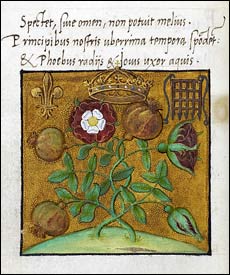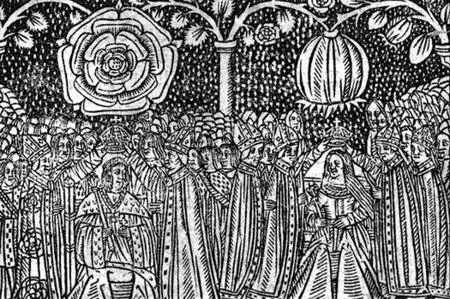
On this day in history, 24th June 1509, Henry VIII was crowned King of England and his new bride, Catherine of Aragon, was crowned Queen Catherine.
The celebrations for the coronation began on the 21st June with Henry riding from Greenwich to the Tower of London, via London Bridge and Gracechurch Street. On the night of the 22nd June various men of royal favour were created Knights of the Bath at a special ceremony and then on Saturday the 23rd there was a special coronation procession.
Eve of Coronation Procession
This procession started at 4pm and consisted of the Knights of the Bath dressed in splendid blue gowns followed by Edward Stafford, Duke of Buckingham, who had been made Constable of England for the day and was richly dressed and carrying a silver baton to denote his special office, followed by the King.
The streets were hung with tapestries and cloth-of-gold and the young and attractive new king was resplendent in a cloth-of-gold coat decorated with gems and a collar of rubies, topped with his red velvet, ermine trimmed parliament robe. His horse was dressed with ermine and cloth-of-gold and the canopy held over him by the four barons of the Cinque Ports was also made of cloth-of-gold. Following Henry came his master of the horse, Sir Thomas Brandon, brother of Charles Brandon, who led the King’s charger, and then came the Queen’s procession led by the Queen herself, reclining in a litter covered by a decorative canopy.
Catherine of Aragon, wearing her auburn hair loose, as was custom at coronations, was dressed in “a rich mantle of cloth of tissue” and was wearing a beautiful gold, pearl and silk circlet on her head. She was followed by a train which included her husband’s former wet-nurse, Anne Luke. David Starkey writes of how Catherine “had already won the hearts of Londoners at Arthur’s wedding. Now she confirmed her hold. And – whatever the vicissitudes of her life – she never lost it.”
The Coronation
David Starkey writes of how this Midsummer’s Day coronation was “a day of rejoicing and mystery: bonfires burned on Midsummer’s Eve and the fairies were abroad. And Henry and Catherine, as they processed on foot through the great hall towards the Abbey church, seemed indeed to be another Oberon and Titania: their magic spell would knit up old wounds and end ancient hatreds, and all, all would live happily ever after.” It was a magical occasion and one which must have filled the common people with hope for the future.

At 8am on the 24th June, Henry and Catherine processed behind twenty-eight bishops from the Palace of Westminster to the Abbey for the coronation ceremony. The Archbishop of Canterbury, William Warham, presented Henry to his people who acclaimed him by calling out “Vivat, vivat rex!“, or “Long Live the King!”, four times. Henry then swore the nine oaths of kingship before Warham anointed him with holy oils and crowned him. Catherine was then crowned Queen of England and the royal party retired to Westminster Hall for a celebration banquet. The banquet was opened by a special procession of dishes, led by the Duke of Buckingham and the Lord Steward, both on horseback.
The celebrations did not end with the banquet. There was a special tournament that night and then two days of jousting and feasting. It was the end of an era and the beginning of a new one, a new age, the reign of King Henry VIII who was to become one of England’s most infamous monarchs.
Notes an Sources
- Henry: Virtuous Prince, David Starkey, p 286-296
- Henry VIII, J J Scarisbrick, p35-36 of my old and battered Methuen version
- First image from a page of Thomas More’s “Coronation Suite”, a collection of poems in Latin written especially for Henry VIII’s coronation. This manuscript can be found in the British Library.